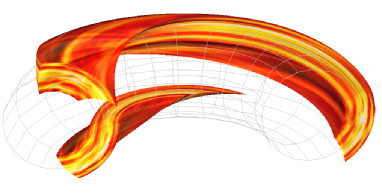Introduction to magnetically confined fusion and gyro-kinetics
Controlled Fusion
The prospect of controlled nuclear fusion as a clean and unlimited power source has motivated physicists in over 50 years of research. The most accessible fusion reactions occur when a plasma of deuterium and tritium is heated to ultra high pressures or temperatures.
Achieving the necessary energy confinement for fusion reactions presents many scientific and technical challenges, and a number of different approaches have been explored. Confining the plasma using magnetic fields has proved to be the most promising of various approaches. The tokamak is a design for a magnetic confinement device with toroidal symmetry which has to date has produced the best energy confinement times. The next generation of tokamak named ITER is an international project that aims to demonstrate the technical feasibility of a fusion reactor on the scale needed for a commercial power plant; it will for the first time produce sustained energy from fusion reactions. Knowledge gained from ITER will be used to build the first demonstration commercial reactor concept.
The tokamak holds a plasma in a quasi-equilibrium but this equilibrium is subject to a zoo of instabilities (unstable modes) since nature likes to reduce high temperature or density gradients. Macroscale instabilities can cause a complete loss of plasma confinement, but small scale instabilities have an important role to play as they are responsible for the plasma losing energy. The physics behind these microturbulent unstable modes is nonlinear and highly complex. Understanding the mechanisms of turbulent plasma transport is of key interest for magnetic confinement fusion, since these phenomena determine energy confinement times in a fusion reactor - a measure of how how much fusion power we can produce.
Modelling Plasma Turbulence
 The solution of the nonlinear equations which describe the kinetic physics of a plasma is not amenable to an analytic treatment and as such requires the use of a computational model. Much like modelling the weather, resolving a number of phenomena interacting over a large range of scales requires a large amount of computing power. Individual particle simulations are presently computationally inaccessible but distribution function models are able to accurately model plasma microturbulence. The evolution of the distribution function of particles in a plasma is described by the 6 dimensional Vlasov kinetic equation, which must be solved self consistently with the internal electromagnetic fields generated by the particles themselves.
The solution of the nonlinear equations which describe the kinetic physics of a plasma is not amenable to an analytic treatment and as such requires the use of a computational model. Much like modelling the weather, resolving a number of phenomena interacting over a large range of scales requires a large amount of computing power. Individual particle simulations are presently computationally inaccessible but distribution function models are able to accurately model plasma microturbulence. The evolution of the distribution function of particles in a plasma is described by the 6 dimensional Vlasov kinetic equation, which must be solved self consistently with the internal electromagnetic fields generated by the particles themselves.
The distribution function is usually decomposed into an unchanging background distribution summed with a perturbed distribution function. By averaging over the ultra fast gyro-motion of the particles around magnetic field lines, the equation can be reduced to the 5 dimensional gyrokinetic Vlasov equation. Such a gyrokinetic model can accurately simulate microturbulence within the plasma, whilst gyroaveraging removes the fastest scale plasma particle motion but still retains all the particle drifts due to field perturbations and magnetic field geometry needed to capture microturbulence.
GKW (Gyrokinetics @ Warwick) is a new flux tube code which solves the nonlinear 5 dimensional gyrokinetic Vlasov equations in a toroidally symmetric geometry. The coordinates used are field aligned Hamada coordinates which allow separation of the different length scales of parallel and perpendicular plasma dynamics. The code uses a combination of finite difference and pseudo-spectral methods with perpendicular dynamics modelled in the wave vector domain. The implementation is designed to allow efficient parallelisation on modern high performance computing clusters. GKW is currently under team development at Warwick based on the previous linear LINART code [1].
Shear Flows
Perpendicular E x B shear flows are regarded as an important mechanism for the quenching of the unstable microturbulent modes of a tokamak. In particular, it is believed that such flows lead to the the formation of transport barriers responsible for higher confinement regimes (H-mode). Whilst perpendicular shearing quenches transport, parallel shear flows can have the effect of driving the unstable modes. A physically realistic scenario of a purely toroidal flow contains a combination of these competing effects and as such is sensitive to geometry parameters such as magnetic shear. Our work is focused on exploring these sensitivities.
Francis Casson 2008
______________________________________________________________________________________________________________
[1] The effect of a uniform radial electric field on the toroidal ion temperature gradient mode, A. G. Peeters and D. Strintzi, Phys. Plasmas 11, 3748 (2004)

